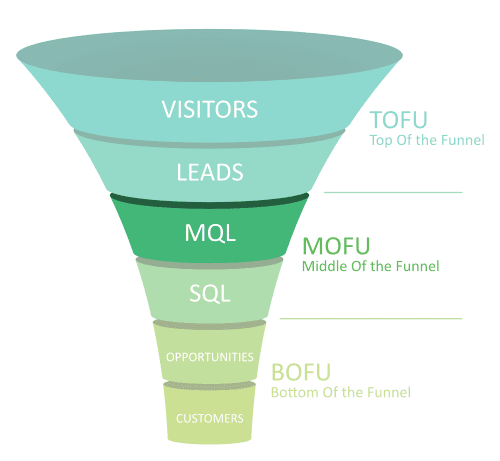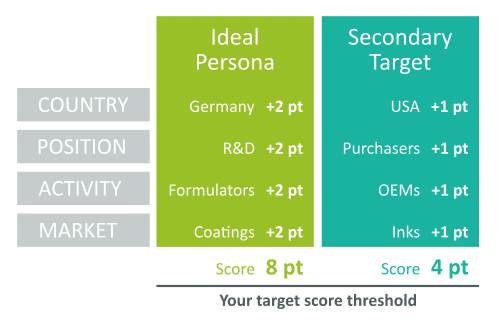The simple guide to MQLs for chemical marketers
It is easy to quickly get lost in the maze of business jargon, and the marketing world is full — even overloaded — of cryptic acronyms and puzzling terms: Lead, MQL, SQL… And to make it even more confusing, everyone has a different definition.
In the chemical industry, this is by far the number one reason why sales and marketing argue with each other. Sales complain about wasting their time with poor-quality marketing leads. Marketers blame the sales reps for not following up on the leads.
To stop this never-ending circle of mutual frustration, the first step your company should take is to share the same definitions across your organization and call a spade a spade.
We’ve built this short guide to help you master some of the most important and basic marketing concepts and, most importantly, start working hand in hand from marketing to sales.
As lead generation and management in specialty chemicals is our field of expertise since 2000, we’ve tailored this guide to share tips and best practices reflecting the challenges of chemical suppliers.
Today we are demystifying the MQL: Marketing Qualified Lead
|
SUMMARY |
MQL: the definition
When visiting your website or blog for the first time, your visitors are unknown. You have no idea who they are, what company they are working for or what they are looking for. Most of them will remain anonymous at this stage and that’s the way it is.
But among your traffic, some visitors will stand out by their online behavior. They will read some articles, browse your content, and at some point, download case studies or subscribe to your newsletter by sharing their email address with you. Congratulations! You have just generated what we call a “lead”.
To transform this “lead” into a “marketing qualified lead”, your marketing team needs to step in.
Their mission is to determine if that person is in your buyers’ target — or buyers’ persona in marketing — and assess if this lead has a strong interest in your chemical products and company.
If it’s a match, the lead is qualified by your marketing team and must be dispatched to your sales team to pursue the buying journey.
A MQL is a lead matching your buyer persona and showing a keen interest in your chemical products, based on the information collected from both your marketing content and campaigns.

Position of MQL in the sales and marketing funnel
How to identify a MQL
The criteria that defines a MQL can significantly vary from one company to another, but can ultimately be grouped into two dimensions:
1. Is the lead in your target?
Using buyer personas is the most common technique to identify your ideal customers and create the relevant content that is most likely to attract them. Does the lead match your target company type, job position and country? What are their objectives and end-applications?
You can collect all the information you need via online forms used to allow access to high-value gated content for example, or use professional social media like LinkedIn to complete your lead profiling.
2. Does the lead have a strong interest?
Analyze the online behavior of your leads to spot the most active ones.
Downloading eBooks or case studies, attending webinars, subscribing to your newsletter… all these interactions are good indicators to identify a lead’s level and topics of interest.
But don’t put the cart before the horse. It is premature to dispatch a lead that only matches your buyer persona’s criteria but shows a limited interest in your content.
It is also futile to ask your sales team to follow up on active leads with incomplete profiles or those outside your target.
To be able to identify MQL, your lead must meet three criteria:
- Share contact details: a valid email address with first and last names
- Match your target profile: a company name or activity and a job position
- Reach an engagement threshold: a specific score in your lead scoring strategy
How to optimize your MQL detection
1. Build your lead scoring
Lead scoring is your best ally to automatically detect your MQLs and every marketing automation tool includes a scoring system.
Combined with progressive profiling, this is the winning combo to complete your leads’ profiles over time and spot your MQLs just when they’re hot.
You can set up your lead scoring in many ways but one of the most effective ways is to split it into two scoring methods as described below.
2. Define your target score
First, the target score, how close is a lead is to your buyer persona.
List the most critical conditions determining if a lead is in your ideal target customer profile. Country, job position, company activity, end applications…once you have collected the basic profile information, via online forms and external sources like LinkedIn for example, you can convert it into a score.
Let’s take a practical example.
Assume that you need 4 criteria to determine if the lead belongs to your buyer persona: country, job position and company activity.
For each criteria, your lead could be:
- in your ideal persona: +2 points
- in your secondary target: +1 points
- unknown or not matching: +0 point
- Excluded: 0-point total
Once you’ve collected all the data, your ideal persona would score 8 points and your secondary target 4 points. In that case, you could set your score threshold at 4, or even higher, 6 for example, to eliminate the leads being too far from your ideal persona.

Example of a basic lead scoring
3. Define your engagement score
Next, let’s look at the engagement score, how engaged is a lead with your solution.
Scoring each action performed on your content and website — with a marketing automation tool for example — is extremely powerful to identify your most active leads and their topics of interest.
Page views, TDS downloads, webinar registrations… each interaction reflects the level of engagement of your leads.
Before running into a complex scoring system, start with a simple yet effective scoring. Put yourself in your prospect's shoes and ask yourself: what online behavior relates to a strong engagement?
Give a score to each engaging interaction by following this simple rule: the more engaging the interaction, the higher the score:
- Weak interaction (page views, videos): +1 point
- Strong interaction (downloads, webinars): +2 points
- Decisive interaction (specific downloads, requests): +6 points
For example, when a lead takes a decisive interaction or has three strong interactions on your website could trigger an alert. As a result, 6 would be the score threshold for your hottest leads.
Every lead triggering both your in-target and engagement score thresholds becomes a MQL.
Once again, this scoring is just one among thousands. Start simple, search for ideas on the internet and be agile when building your own scoring: test, measure, improve and loop again.
From lead to MQL, how to improve your conversion rate
Identifying a MQL among your leads is, or will be, one of the top priorities of your marketing department. To make the task easier, we’re sharing our best practices to help you improve lead-to-MQL conversion.
1. Share the same definition across your sales and marketing teams
If you take only one learning away from this article, make it this one: Having the same MQL definition across your teams is the most important step to success.
Creating your MQL definition is not only the job of marketing. It is a task involving your marketing and sales teams. Agreeing on what is a good or a bad lead helps the usual frustration to magically vanish and enables a smooth transition of a MQL from marketing to sales.
2. Sync your marketing automation to your CRM
To make sure your hottest leads won’t slip through the cracks, you should better synchronize your lead scoring to your CRM. Both your sales and marketing teams have easy access to the leads’ information and can be notified once a lead reaches your score threshold.
Centralizing all your leads data in your CRM is also interesting for progressive profiling. Based on the information you already know about a lead, your marketing automation tool will adapt the online forms to collect missing data, complete leads’ profiles over time and improve your user experience with shorter forms.
3. Watch your conversion rate
Conversion rates from a lead to a MQL will strongly depend on your industry and business activity.
Comparing your conversion performance to B2B averages on the Internet makes little sense — especially in the chemical industry which has been lagging in the effective use of digital marketing for quite some time.
Start with your current baseline: keep track of the percent conversion of a lead to a MQL and identify your bottlenecks to improve.
Don’t waste your time comparing yourself. Progress at your own pace and keep an eye on your performances.
You can also seek coaching from digital experts in the chemical industry. At SpecialChem, we run lead management workshops to help chemical suppliers defining their buyer’s persona, building their MQL criteria, and improving their lead conversion with actionable best practices and recommendations.
